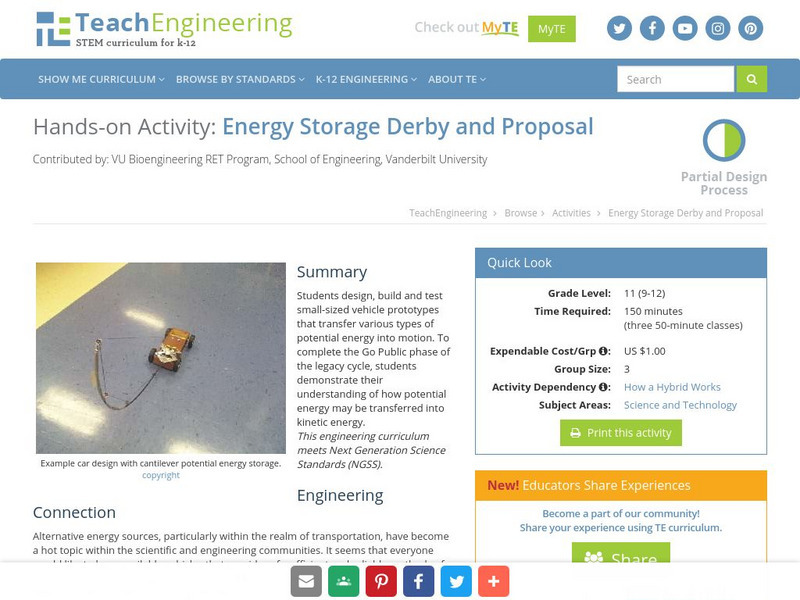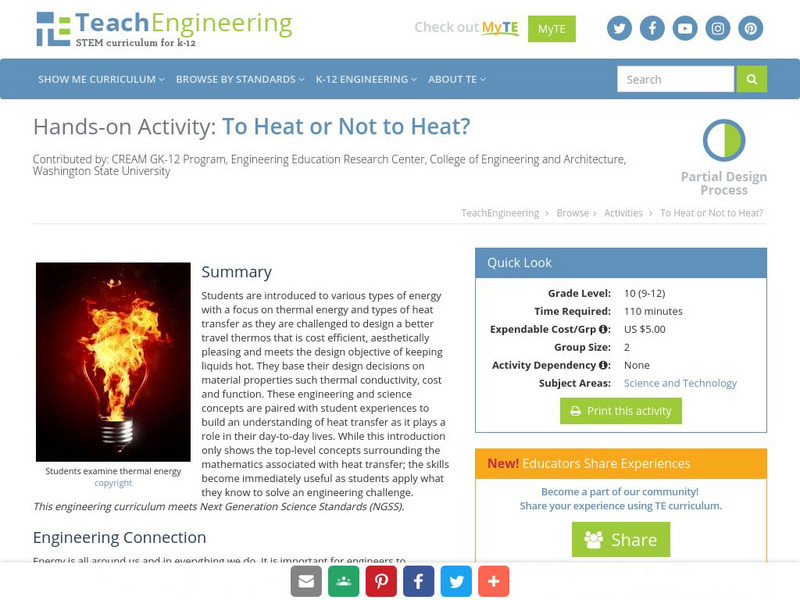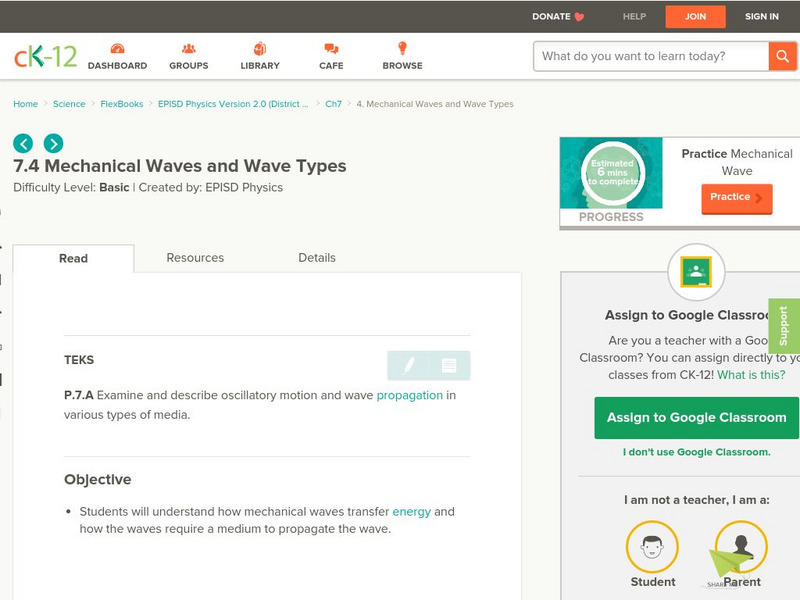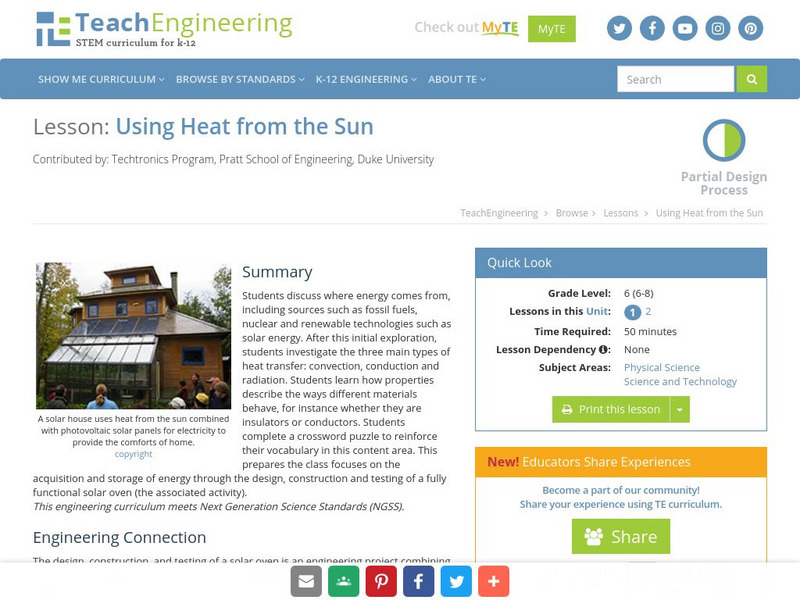TeachEngineering
Teach Engineering: Energy Storage Derby and Proposal
In Activity 5, as part of the Going Public step, students demonstrate their knowledge of how potential energy may be transferred into kinetic energy. Students design, build and test vehicle prototypes that transfer various types of...
Climate Literacy
Clean: How Much Energy Is on My Plate?
This activity leads students through a sequence of learning steps that highlight the embedded energy that is necessary to produce various types of food. Students start by thinking through the components of a basic meal and are later...
TeachEngineering
Teach Engineering: To Heat or Not to Heat?
Students are introduced to various types of energy with a focus on thermal energy and types of heat transfer as they are challenged to design a better travel thermos that is cost efficient, aesthetically pleasing and meets the design...
TeachEngineering
Teach Engineering: Solar Water Heater
Student teams design and build solar water heating devices that mimic those used in residences to capture energy in the form of solar radiation and convert it to thermal energy. This thermal energy is next transferred to water (to be...
TeachEngineering
Teach Engineering: What Is Heat?
Students learn about the definition of heat as a form of energy and how it exists in everyday life. They also learn about the three types of heat transfer as well as the connection between heat and insulation.
Other
Ed informatics.com: What Is Work, Energy and Power?
Defines work, energy, and power. Explains the work-energy principle, types and forms of energy, and presents some exercises to try.
Alabama Learning Exchange
Alex: Understanding Solar Energy. Part 1
This lesson plan discusses how electromagnetic radiation transfer the sun's energy to earth. This lesson plan will also talk about the eight types of electromagnetic waves in the electromagnetic spectrum and how each type is used or...
Other
Characteristics of Energy and Matter
A lengthy page from the Fundamentals of Physical Geography site. Energy is distinguished from matter, and the different forms of energy are identified and discussed. Four types of heat transfer (convection, advection, conduction,...
CK-12 Foundation
Ck 12: Mechanical Waves and Wave Types
[Free Registration/Login may be required to access all resource tools.] By watching video clips, doing interactives, and reading text, students discover how mechanical waves transfer energy and how the waves require a medium to propagate...
Shmoop University
Shmoop: Ecosystem Energy Flow
Explains the processes by which energy flows through an ecosystem. Covers the meanings of key vocabulary, e.g., types of producers and consumers, trophic levels, food webs, and the energy pyramid.
PBS
Pbs Learning Media: The Electromagnetic Spectrum: Frontline
This video segment adapted from FRONTLINE introduces the electromagnetic spectrum and explains how the various types of electromagnetic waves are distinguished by the amount of energy each wave carries.
Soft Schools
Soft Schools: Waves
Take an interactive quiz over energy waves. After completing the quiz, check your score, and then revisit any incorrect question for further review.
TeachEngineering
Teach Engineering: Using Heat From the Sun
In this lesson, students will first discuss where energy comes from, including sources such as fossil fuels, nuclear, and such renewable technologies as solar. After this initial exploration, students will investigate the three main...
Science Education Resource Center at Carleton College
Serc: Construction of a Complex Machine Through Classroom Collaboration
Learners take a simple task and make it much more complicated using a cardboard box. Each group must use a minimum of six simple machines utilizing at least four types of simple machines. The goal is to keep the initial impulse moving...
Oklahoma Mesonet
University of Oklahoma: Overview of Meteorology
The University of Oklahoma explores numerous types of weather and atmospheric changes, as well as the reasons behind them. Content details the four seasons, common meteorological variables, the vertical structure of the atmosphere, how...
PBS
Pbs Teachers: Daredevil Ball Jump Experiment
Construct a device to measure the height of a bounced ball, then compare the bouncing heights of various types of balls. Record the results on a chart.
Concord Consortium
Concord Consortium What Are All Materials Made Of?
Activity 3 of this module explores: Is the particle model always better? Models are considered most useful when a variety of observations can be explained. A model of matter should explain observations of all types of matter. In this...
















